The Underground Index

Getting around large, busy cities can be challenging, especially when traveling at rush hour. Commuting to your job in a major city by car, bus, or other road vehicle can be risky, with traffic jams and congestion making it a long and stressful experience. To solve this problem, many large cities have developed expansive metro systems, helping residents, commuters, and visitors get from A to B with as little disruption as possible.
Europe has proven to be a hotbed for the development of metro systems, particularly in capital cities, with the London Underground being one of the most recognizable. This form of public transport is especially beneficial to the region as many cities are very old, with streets and road infrastructure not designed for heavy vehicle traffic.
However, while these systems are undeniably helpful, the user experience and quality of available facilities can vary significantly. Some metros experience incredibly high volumes of passengers, especially at peak times, while others might have confusing layouts, making them difficult for tourists to navigate.
With this in mind, the travel and luggage experts at Bounce have uncovered the European capitals with the best metro systems. We’ve considered a range of variables, from the average Google review score of stations to factors like the distance covered by the system, the number of stations, the annual ridership, and the percentage of positive and negative online reactions to news about each metro. This data has all been compiled into a single ‘underground index’ score, allowing us to reveal Europe's best and worst metro systems.
The European capital cities with the best metro systems
Get the app to unlock rewards

Book with the app and earn 10% back in Bounce credits. Every booking unlocks more credits for your next trip.
Scan to download

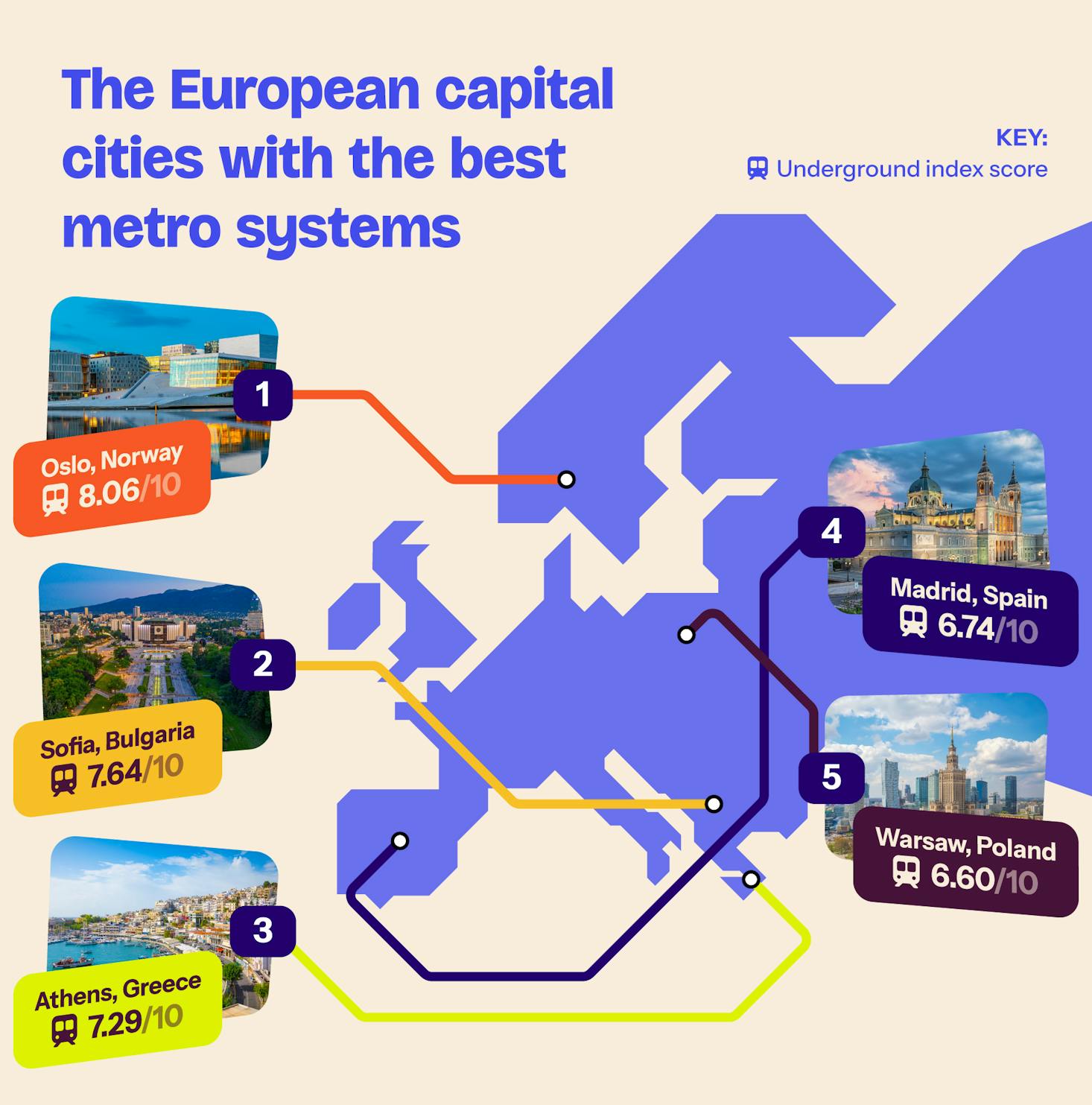
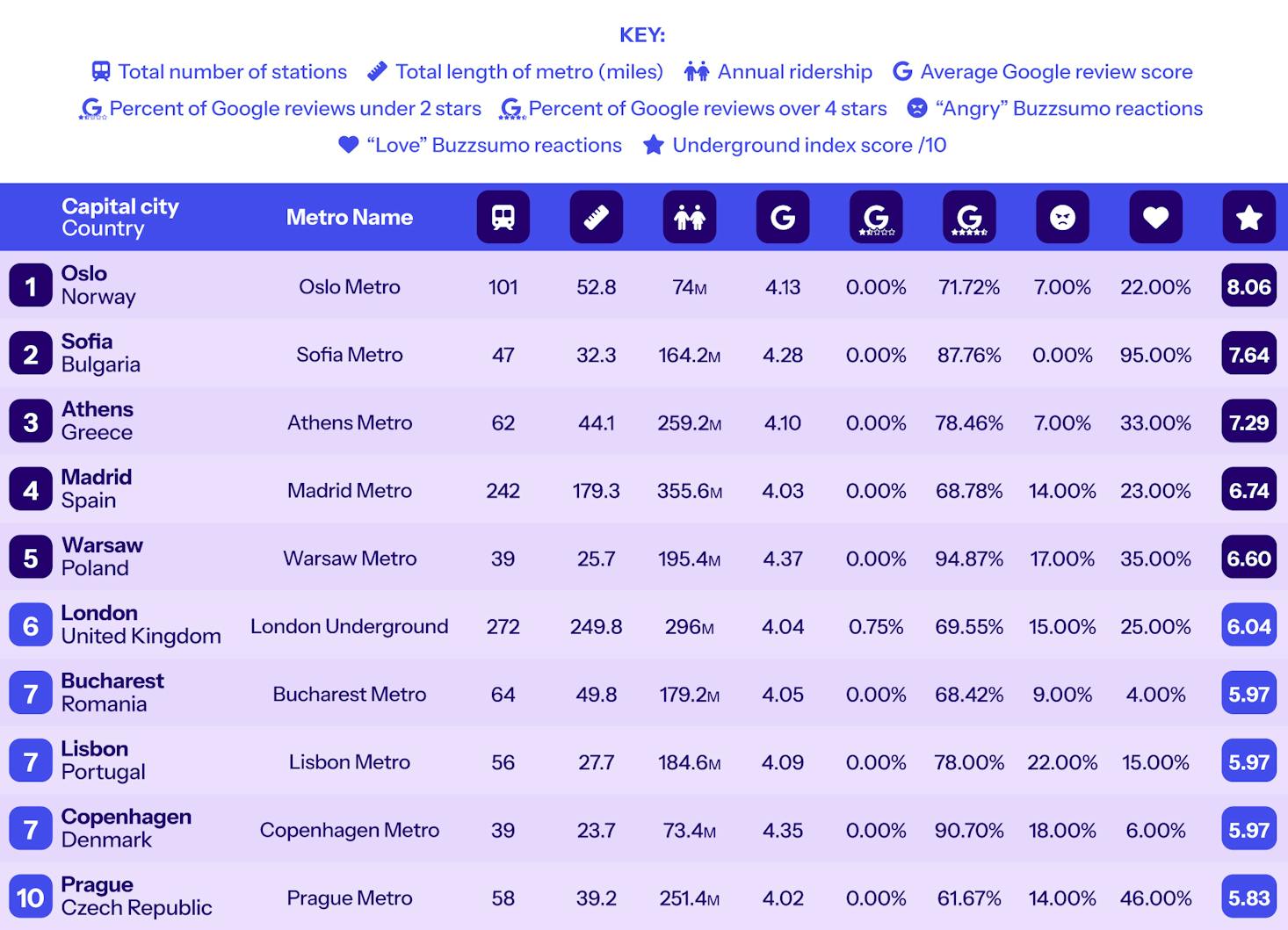
1. Oslo, Norway | Underground index score: 8.06/10
Oslo has the best metro system in Europe, with an underground index score of 8.06 out of 10. The Oslo Metro, known locally as either the “Oslo T-Bane” or “T-banen i Oslo,” has 101 stations covering 52.8 miles of track and serves all 15 city boroughs, as well as extending part-way into the neighboring Baerum municipality.
The Olso Metro comprises five separate lines, with another currently under construction. All five lines pass through the Common Tunnel in central Oslo, allowing travelers to access any line across the tunnel’s six stations.
With an average Google review score of 4.13 out of 5 across all stations, the Oslo Metro is well-regarded by users. The system’s busiest station, Jernbanetorget, is part of the largest transport hub in Norway, along with Oslo Bus Terminal, Oslo Central Station, and the attached tram station. Jernbanetorget has been described as “easy to get around,” “very well organized,” and “nice and clean” in its many reviews.
2. Sofia, Bulgaria | Underground index score: 7.64/10
The Sofia Metro, or “Софийски Mетрополитен” in Bulgarian, is the second-highest-scoring metro system in our study, with a score of 7.64 out of 10. Serving the Bulgarian capital of Sofia, it is the only metro system in the country and one of the youngest in our study, only opening to passengers in 1998.
The city’s metro system covers 32.3 miles of track and is accessible via 47 stations, including one at Sofia Airport, making travel to and from the city a breeze. The airport station has a Google review score of 4.10 out of 5 and is described as cheap and easy to use by many reviewers. There’s plenty of English signage, including payment instructions, making it a simple and accessible experience for foreign visitors.
The two highest-rated stations on the Sofia Metro are Aleksandar Malinov and Moesia/NBU stations, which earned Google review scores of 4.70 out of 5. The Moesia/NBU metro station is located in a suburban area of western Sofia and is praised by many reviewers for its cleanliness. Aleksandar Malinov station is situated in the Mladost area of southern Sofia and is praised by many for its beautiful architecture and decor, such as the modern forest-like artwork that decorates one of the platforms.
3. Athens, Greece | Underground index score: 7.29/10
Athens has the third highest-rated metro system, with an underground index score of 7.29 out of 10. Like Sofia, the Athens Metro provides a direct link to the airport, allowing travelers to access the city center with cheap, quick, and regular public transport. The metro also connects to the city’s busy port area, which supports travel by ferry to many Greek island destinations, including Crete, Rhodes, Naxos, and Mykonos.
The Athens Metro has 62 stations across 44.1 miles of track and sees more than a quarter of a million passengers every year, making it an integral part of the city’s transport infrastructure. The average Google review score for all metro stations in the city is 4.10 out of 5, showing widespread approval of their condition.
Syntagma station, located at the political heart of Athens next to Syntagma Square, is the busiest in the Athens metro system and has a Google review score of 3.50 out of 5. While generally positive, the busy nature of this station is cited in many reviews and is likely why the station doesn’t score higher. Positive reviews of Syntagma station praise it for being “modern, spacious, clean,” while the exhibits on the ticket hall level are also a highlight of some travelers’ experiences.
The European capital cities with the worst metro systems
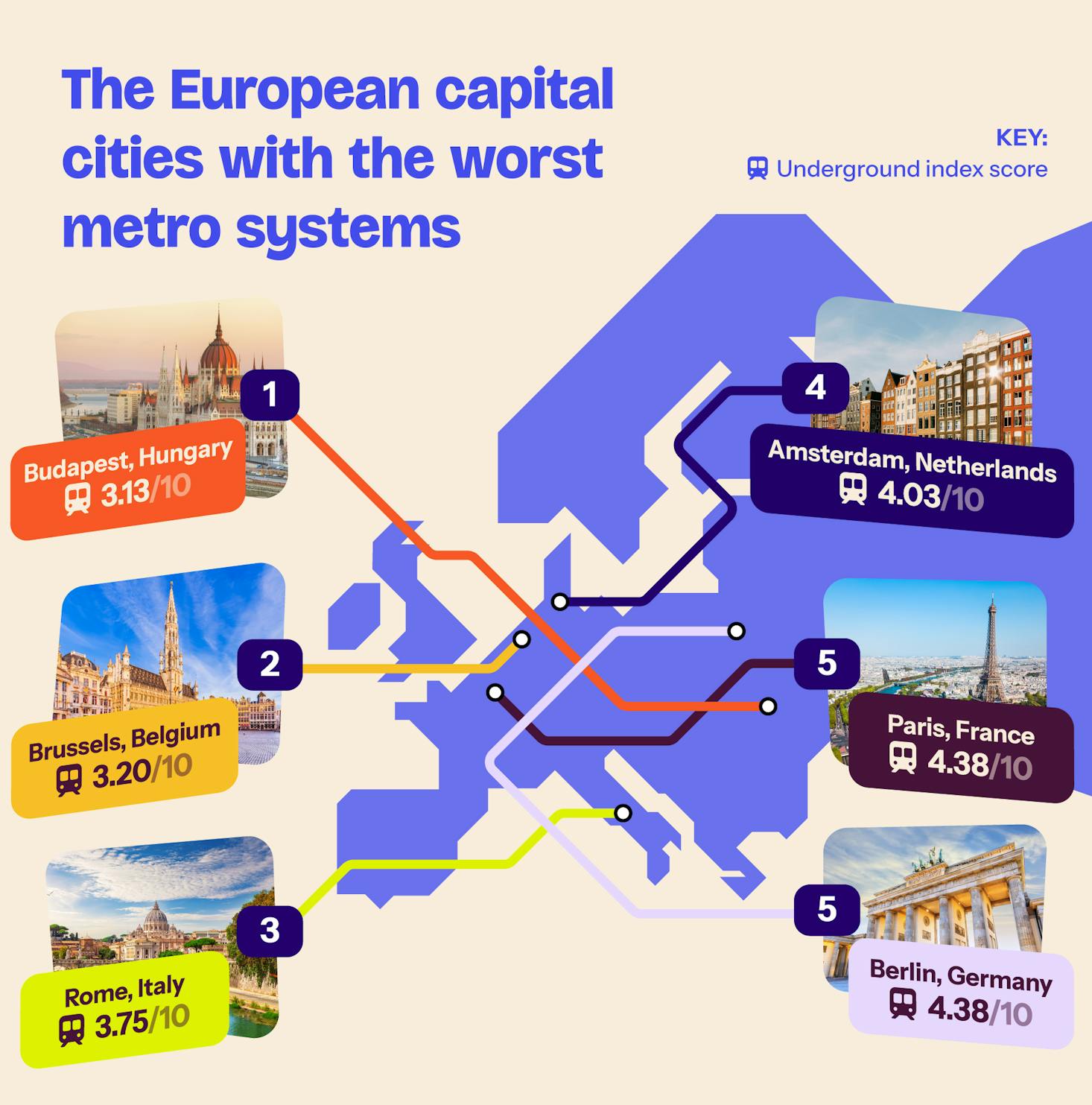
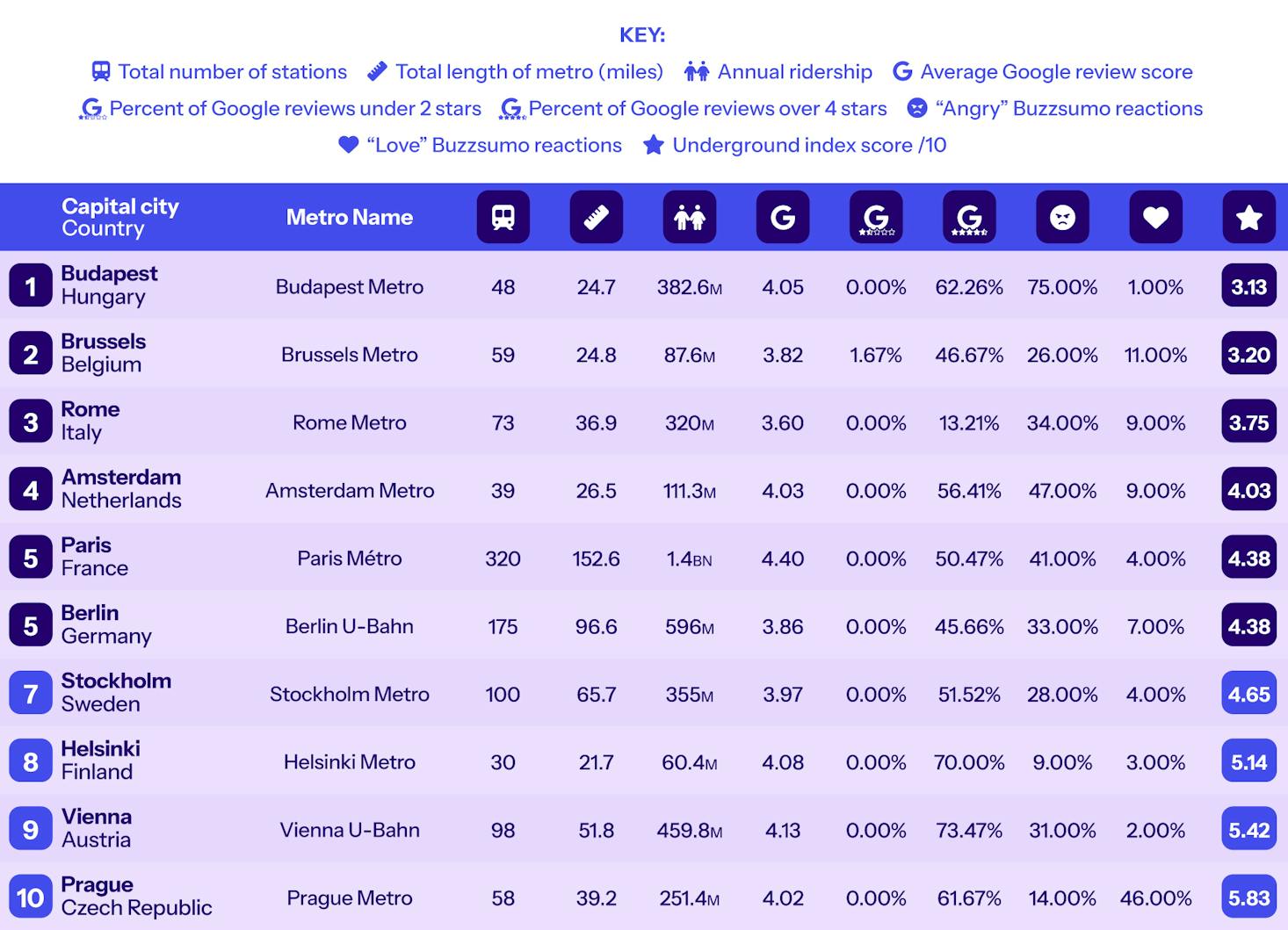
1. Budapest, Hungary | Underground index score: 3.13/10
Budapest Metro, or “Budapesti Metró” in Hungarian, is the lowest-rated metro system in our study with a score of 3.13 out of 10. The Budapest metro system is relatively small, with 48 stations across just 24.7 miles of track, while it has a disproportionately larger number of annual passengers at over 382 million.
While the average Google review score across all metro stations was a respectable 4.05 out of 5, 75% of online reactions to articles about the metro system were “hate,” while just 1% of reactions were “love.”
Állatkert is Budapest’s highest-rated station, scoring five out of five. The station is located next to the Biodóm zoo, which is within the bounds of Városliget, Budapest’s city park. Határ út metro station
Határ út station is the city’s lowest-rated metro stop, earning a Google review score of just 2.80 out of 5. The station appears to receive a lot of criticism for its poor looks, with comments describing it as “a rather unpleasant place” and also saying it “looks pretty terrible.” Cleanliness is another major complaint at the station, repeatedly cited in reviews with comments like “moldy stalls,” “a lot of garbage,” and “simply disgusting.”
2. Brussels, Belgium | Underground index score: 3.20/10
Brussels Metro has the second-lowest underground index score of 3.20 out of 10, performing just slightly better than Budapest. It has 59 stations along 24.8 miles of track covering the wider Brussels metropolitan area.
Besides being the Belgian capital, Brussels is an important European city as it co-hosts the European Parliament along with Strasbourg. Each year, the metro carries more than 86 million passengers, making it a vital part of the city's infrastructure while reducing traffic and congestion on the roads.
However, the Brussels Metro is relatively unpopular online compared to other cities’ systems, with 26% of online article reactions being “hate” and only 11% being “love.” The Google review scores for stations on the Brussels Metro are also underwhelming, with an average score of 3.80 out of 5.
The busiest metro station on the Brussels Metro is Gare du Midi, which is also the lowest-rated, with a Google review score of just 1.90 out of 5. This metro station is located in central Brussels and connects passengers to the city’s main train station. Reviewers have left some pretty scathing remarks online, describing Gare du Midi as the worst station in Belgium and even Europe. Multiple reviewers refer to the station as “unsafe” and “dangerous,” with many others referencing the strong smell of urine that travelers must contend with.
3. Rome, Italy | Underground index score: 3.75/10
Rome Metro had the third-lowest underground index score of 3.75 out of 10. The Italian capital’s metro system is more extensive than those of Budapest and Brussels, with 36.9 miles of track accessible via 73 stations. The metro is integrated with a system of commuter trains called FL lines that offer more extensive connections to surrounding areas, including Rome Fiumicino Airport.
While the metro system in Rome is extensive and well-connected to other public transport options, the average Google review score of metro stations is just 3.60 out of 5, with only 13.21% of stations receiving a score of four or above. Additionally, 34% of online reactions to news articles about the Rome Metro are “angry,” while “love” reactions account for just 9%.
Quintiliani is the worst-reviewed metro station in Rome, with a score of just 2.40 out of 5. Many of the reviews for this station reference the lack of staff and security, which, along with the “desolate” surrounding area, makes many travelers feel unsafe. Station facilities, including elevators and ticket machines, have been referenced multiple times for being out of action, making travel here more difficult for passengers.
Two comments that sum up the listed issues with Quintiliani metro station include it being “the most useless station ever” and a “perfect example of a poorly looked after place.”
The French capital has the most metro stations in Europe

The Paris Metro has 320 stations along its 152.6 miles of track, more than any other metro system in Europe. This makes it very easy to reach any part of Paris without walking great distances or traveling by road, which is great news for visitors and tourists who are less familiar with the city layout.
While the average review score for stations on the Paris Metro is a respectable 4.40 out of 5, the system’s busiest station also has the lowest review score of the network, at just 2.40 out of 5.
Gare du Nord metro station is connected to the railway station of the same name, which sees huge volumes of passengers pass through it daily.
Travelers using this metro station should be wary of pickpockets, which have been cited in many reviews as a persistent problem. The other major issue that many reviewers mention is hygiene, with one reviewer’s experience leading them to claim that “Paris has not changed since the Middle Ages in terms of cleanliness.” While this is definitely an exaggeration, another reviewer compared their experience here to the medieval period, referring to it as “a real shame for France, the courtyard of miracles like in the Middle Ages,” (the courtyard of miracles being a French term for the city’s medieval slum districts), while another traveler even claimed they “screamed in disgust.”
London’s tube system covers the greatest distance

The London Underground is Europe's most extensive metro system, with 249.8 miles of track served by 272 stations. London is a vast city with 32 separate boroughs, all of which are well-served by the city’s metro system. Colloquially referred to as “the Tube,” this series of metro lines stretches well beyond the city limits, reaching into the surrounding counties of Hertfordshire, Buckinghamshire, and Surrey.
The London Underground took sixth place in our study, earning an Underground Index Score of 6.04 out of 10. The average Google review score for stations in the system is 4.04 out of 5, with 69.55% being rated four stars or above. However, a small number of stations were rated below two stars, accounting for 0.75% of the total.
London’s busiest tube station is King's Cross St Pancras. The tube station has a Google review score of 4.40 out of 5, making it one of the most highly rated in the city despite a huge volume of passenger traffic. Many reviewers praise the station's cleanliness and beautiful architecture, while the friendly staff and comprehensive wheelchair access are also frequently applauded. However, while the station is well-regarded, many reviews warn of lengthy walking distances between platforms and how busy the station can get, especially during rush hour.
Finland’s Helsinki metro system is the least busy

Helsinki has the metro system with the fewest annual passengers in our study, with an annual ridership of 60.4 million. This suggests that the Helsinki Metro will be considerably less crowded than the larger European metros, providing a less hectic experience for travelers.
The Helsinki Metro is the smallest in our study, with just 30 stations across the city’s metropolitan area, with an average Google review rating of 4.07. The busiest of these stations is Rautatientori, known as Central Railway Station metro station in English. As the English name suggests, Rautatientori is connected to Helsinki’s Central Railway Station, from which passengers can travel to the airport and other Finnish cities.
The most popular metro station is Kivenlahti, which is rated 4.60 and frequently praised for its cleanliness and calm atmosphere. In contrast, the lowest-rated Helsinki Metro station is Sörnäs, which has earned a review score of 3.50. Sörnäs is one of the busier, centrally located stations and has received mixed reviews. Multiple reviewers praise the station for its ease of use and connections to other parts of the city. However, many reviews discuss drunkenness at the station, so travelers may want to bear this in mind when passing through.
Sofia’s metro system has the most positive reactions online

The Sofia Metro performed very well in our study, claiming second place overall. This is reflected in public reactions to online articles about the system. A huge 95% of online reactions to articles were “love” reactions, while there were zero “hate” reactions, which is a testament to the metro’s popularity.
According to Google reviews, Sofia Central Railway Station's metro station is the lowest-rated, scoring 3.70 out of 5. Many reviewers report being unhappy with the station's facilities, including having to pay to use the toilets, being unable to pay by card, and finding the elevators out of order. These factors can all make travel through the station more difficult, especially for visitors without a firm grasp of the Bulgarian language.
However, the first metro station most visitors and tourists will encounter is Sofia Airport, which has a much more encouraging rating of 4.10 out of 5. Reviewers frequently compliment the station’s cleanliness and speedy connection to the city center. However, many complaints discuss rude staff and difficulties paying for the correct tickets due to a lack of English language instructions for visitors. With this in mind, learning at least some key phrases in Bulgarian before traveling would be helpful, and not taking it personally if staff are not as friendly as you’re used to.
Warsaw metro stations have the highest average Google review score
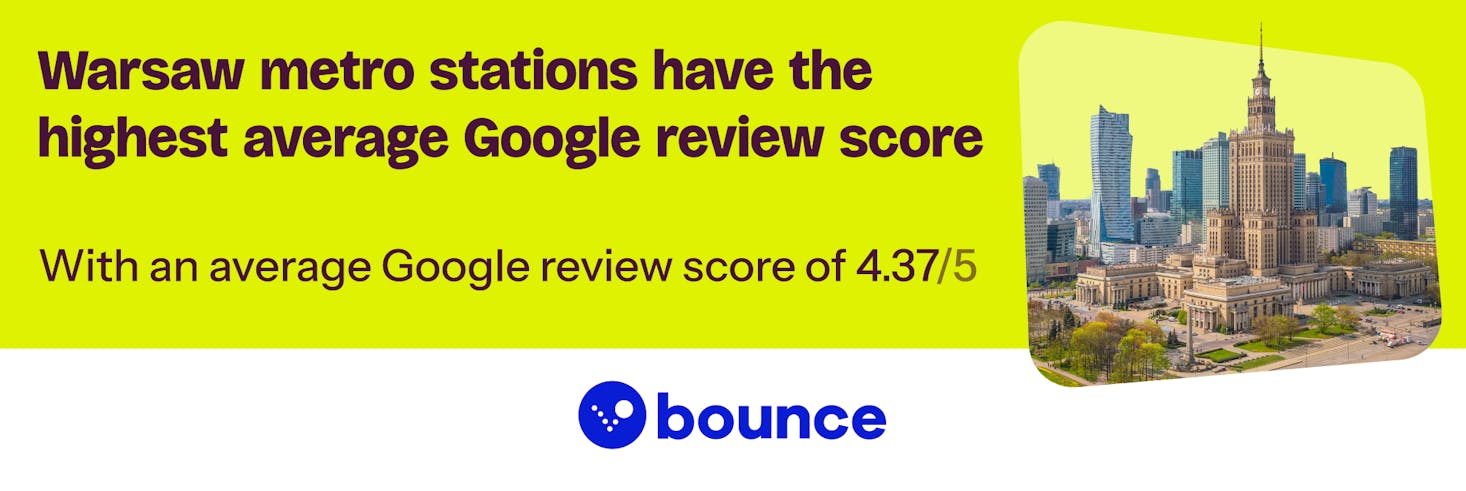
Metro stations in Warsaw have the highest average Google review score at 4.37 out of 5, indicating high satisfaction with the system overall. This is reflected in the 35% of reactions to online articles being “love,” twice the number of “hate” reactions.
The Warsaw Metro is one of the smallest systems across European capitals, with 25.7 miles of track served by 39 stations. Despite its smaller size, the Warsaw Metro transports more than 195 million passengers annually, showing that it is a vital part of local infrastructure.
Plac Wilsona and Mlynow stations are the two most highly rated across the Warsaw Metro, both earning review scores of 4.70 out of 5. Plac Wilsona station, just north of the city center, is frequently referred to as the most beautiful station in Warsaw, with comments such as “extraordinary architecture” to describe the impressive vaulted ceiling.
Mlynow station is located in Warsaw’s Wola district, home to the city’s business district, the beautiful Edwarda Szymańskiego Park, and the Warsaw Rising Museum. The cleanliness of Mlynow station is repeatedly mentioned in reviews, as are the bright neon lighting and modern aesthetic.
Cody Candee, CEO and Founder of Bounce, comments:
“Traveling in Europe can be daunting, especially if it’s your first time abroad or you’re not confident with the local language. This can put visitors off using public transportation, as they may be worried about getting lost and not being able to read the signs or purchase the right ticket.
However, public transport in Europe is generally of a very high standard, relatively affordable and is often well-signposted with English-language directions and instructions, alongside the local language, making it more accessible and easier to use. Many stations also have luggage storage facilities nearby, meaning you can store your bags in a convenient location while exploring the city.
Travelers in Europe might go their entire trip without ever getting in a car. Many airports have their own metro or railway station with links directly to the city center, while buses and metros can often take you to any part of larger cities. Additionally, cycling can be a very popular means of transportation in some countries, such as the Netherlands, while many cities are designed to be walkable.
Aside from being a quick and practical way of getting around, many metro stations have beautiful designs, and visiting them can be an experience in itself. However, not all stations are made equal, and some may lack certain facilities or accessibility features, such as elevators, toilets, or staff. Additionally, some larger stations have a reputation for pickpockets, so tourists are advised to remain aware when passing through.
If you’re worried about any of these issues, take the time to research the stations you’ll be using. There may be an official website you can check to see what facilities are available, and reviews could let you know if there are any frequent issues like pickpockets or broken ticket machines. You might consider using secure luggage storage to reduce what you’re carrying, making it easier to get around and reducing targets for pickpockets.”
Methodology
We wanted to reveal the best metro systems across European capital cities. To do this, we made a list of European capital cities with metro systems and recorded the Google review score of every metro station. This allowed us to calculate an average review score for each metro system. We also recorded the percentage of stations in each metro system with Google review scores of four or higher and the proportion of Google review scores below two.
We then used data from Wikipedia to record each metro system’s number of stations, the total length of track, and the most recent annual ridership figures. Additionally, we used Buzzsumo to record the proportion of “love” and “hate” reactions given to online articles about each metro system.
These factors were combined into a single Underground Index Score to reveal the best and worst metro systems. Moscow and Kyiv metro systems were excluded due to the ongoing war in Ukraine. Minsk metro was not included due to the U.S. Department of State’s level 4 advisory against travel to Belarus.
Get the app to unlock rewards

Book with the app and earn 10% back in Bounce credits. Every booking unlocks more credits for your next trip.
Scan to download

